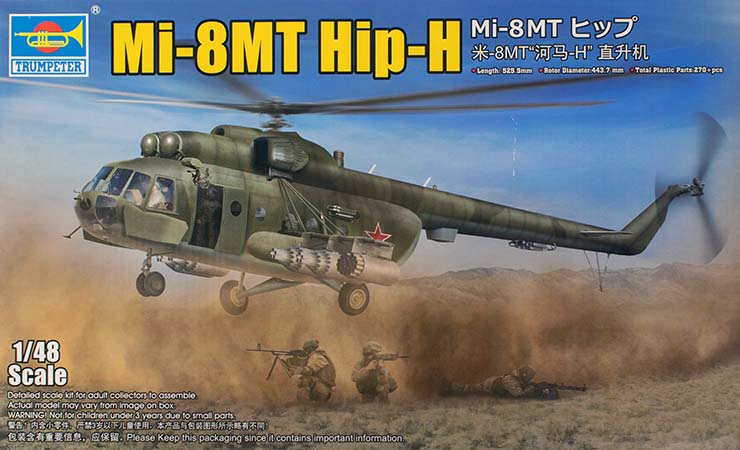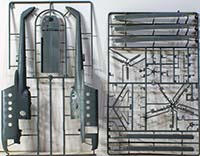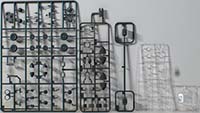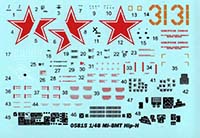
Trumpeter 1/48 Mi-8MT/Mi-17 Hip H Kit First Look
By Michael Benolkin
| Date of Review | May 2023 | Manufacturer | Trumpeter |
|---|---|---|---|
| Subject | Mi-8MT/Mi-17 Hip H | Scale | 1/48 |
| Kit Number | 5815 | Primary Media | Styrene/Photo-Etch |
| Pros | Nice Detailing, Excellent Subject Possibilities | Cons | See text |
| Skill Level | Intermediate | MSRP (USD) | $124.95 |
First Look
 |
 |
 |
 |
 |
As I’ve heard quoted many times on television, the vast territories of the former Soviet Union were made for the helicopter. The Mil OKB, the design bureau named for its chief designer, Mikhail L. Mil, was the moving force behind rotary-winged aviation in the former Soviet Union. Its first principal workhorse for the Soviet Army was the Mi-4, codenamed Hound, which bore a strong resemblance to its Russian-American cousins, the Sikorsky H-19 and H-34 series.
With the availability of turbine power, the United States fielded the Bell UH-1 Iroquois in the late 1950s (then designated as the HU-1A, where it gained its nickname ‘Huey’), which would become one of the most widely used helicopters in the world. Within a few years of the UH-1, Mil was given the green light to develop a new turbine powered utility aircraft, the V-8. This prototype flew in 1961 and bore a strong resemblance to the Mi-8 of today with one exception; it only had a single engine. Mil wisely added a second engine to the production versions that followed.
The Mi-8 was employed as the Soviet Army’s principal workhorse, and with its spacious interior, it would be adapted into troop transport, cargo aircraft, communications aircraft, gunship, electronic warfare platform, airborne command post, rescue helicopter, and more. With the addition of a boat hull, the Mi-8 would become an amphibious anti-submarine warfare and SAR aircraft, re-designated as the Mi-14. When the US took the power train from a UH-1 and build an attack helicopter that would become the AH-1 Cobra, the Mil OKB adapted the best parts of the Mi-8 and Mi-14 to create the Mi-24 Hind.
For those who love trivia questions, what was the most heavily armed helicopter in the world during the 1980s? If you said the Mi-8, you would be correct! While the Mi-24 was heavily armed, it only carried four rocket pods and four anti-tank missiles in addition to its cannon. The gunship version of the Mi-8 carried SIX of those same rocket pods, four anti-tank missiles and the cannon. US helicopters at that time did not carry that kind of firepower, and I daresay that is still true today.
The Mi-17 would become the export version of the improved Mi-8, the Mi-8MT. The main visual difference between the previous Mi-8s and the Mi-8MT/Mi-17 is the tail rotor. The previous Mi-8s had the tail rotor on the starboard side, the later on the port side. Over 11,000 Mi-8/Mi-17 have been produced and sold around the world, where they continue to serve today.
Trumpeter’s latest impressive kit is the 1/48 scale Mi-8MT/Mi-17 Hip H helicopter. Molded in light gray styrene, the kit comes on 21 parts trees, plus two clear trees, and one set of photo-etched parts. As with some of the previous kit releases, this kit suffers from a few ejector pin marks along the cabin interior walls and on the clamshell cargo doors. With a little careful sanding, the ejector pin marks on my example appear to be easily dealt with.
Trumpeter did release this kit in 1/35 scale almost 20 years ago, but some of the criticisms of that release have been addressed in this kit. The super-detailed engines are not here, so displaying this kit in maintenance mode is not an option. The 1/35 scale kit was unarmed and lacked even weapons pylons. This kit not only has pylons, but two different rocket pods (six of each), so you can mix or match your rocket load-out, though no anti-tank guided missiles are included. Supplemental armor plates are included for around the cockpit and other areas, and the kit even has defensive chaff/flare launchers and exhaust heat suppressors included.
The main cabin and cockpit have fully detailed and enclosed interiors. The only room for detailing I can see here is the space behind the instrument panels lacks detail and wiring that would be visible through that greenhouse canopy. On the other hand, photo-etched seatbelt and harness buckles are provided. There are no seats nor any other details provided inside the main cabin, replicating a standard trash hauler. If you want the aircraft in any other configuration, you'll need to provide your own parts.
The kit can be positioned with the crew entry door open or closed, the cockpit side windows open or closed, and the clamshell cargo doors open or closed. Out of the box, the kit does not appear to be set up for other versions of the aircraft as there are no flashed-over holes in the fuselage and the IR countermeasures device is molded onto the fuselage.
With over 11,000 Hips out there in the world, you can imagine the vast number of paint jobs that this aircraft carries. In this kit, markings are provided for two examples:
- Mi-8MT, standard camo, Russian Federation
- Mi-8MT, Bort 31, standard camo, Russian Federation
Here is a kit of an aircraft that has served many countries around the world, in numerous conflicts, as well as being modified into a wide variety of configurations. This kit provides the modeler with a vast number of possibilities to create a colorful subject that will look great on your shelf and on the contest table.
References:
- Mil Mi-8/Mi-17, Yefim Gordon/Dmitriy Komissarov, Midland Publishing, 2003, ISBN 1-85780-161-X







